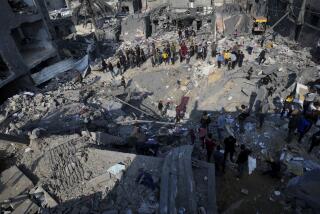The siege
For weeks now, 21st century implements of war have been rolling, soaring and sailing across the sand, sky and sea in and around Iraq. But as U.S. troops mass around Baghdad, the conflict increasingly suggests something downright medieval: a city under siege. And history is full of sieges with surprise endings.
Traditionally, a siege is the military blockade of a city or another fortified place, with the goal of prevailing by force or attrition. In its purest form, an army laying siege cuts off its enemy from all outside communication or replenishment of food or ammunition. Though one Pentagon official said Wednesday that the plan is to âlay siegeâ to Baghdad, many political and military leaders in the U.S., wary of suggesting a protracted engagement and eager to win hearts and minds along with territory, have shied away from the word. To many observers in the wider world, however, a city surrounded and assaulted is a city besieged, and thatâs what Baghdad looks like.
The wordâs roots are in the Latin sedere, to sit. From the biblical accounts of the Babylonian King Nebuchadnezzarâs two-year siege and destruction of Jerusalem in the 6th century BC to wire-service reports from Vietnamâs hills 35 years ago, it has remained a recurring yet risky feature of conflict, involving combatants from Sun Tzu to Napoleon and observers from Mark Twain to Michael Herr.
âMy initial response to the word âsiegeâ was, âOh, no,â because a siege of a civilian city is a horrific thing,â said Eugenia Kiesling, a civilian professor of history at the U.S. Military Academy at West Point. âSieges have been out of fashion for a couple of centuries, specifically because they do inflict such suffering on civilian populations.â
In fact, Kiesling made the subject Topic A for her cadets on Wednesday. U.S. forces appear to have no easy choices in this case, she told them, but if Iraqi troops donât come out from the city to fight and the confrontation takes on the character of a siege, âit would rest uneasily with our overall strategyâ of distinguishing the Iraqi people from the regime.âThe highest form of generalship is to balk the enemyâs plans,â writes Chinese strategist Sun Tzu in his 2,400-year-old classic, âThe Art of War.â The next best option, he continues, âis to prevent the junction of the enemyâs forces. The next in order is to attack the enemyâs army in the field. And the worst policy of all is to besiege walled cities. The rule is, not to besiege walled cities if it can possibly be avoided.â
It was the siege of Masada -- nearly two years of attack by 15,000 Roman troops against fewer than 1,000 men, women and children in a mountaintop fort, nearly all of whom perished -- that ended Jewish rule in Palestine in AD 70 and became an enduring symbol of valor for Jews at war ever since.
Seventeen centuries later, in 1793, it was his brave but risky prosecution of a siege at the port of Toulon that got a young artillery commander named Napoleon Bonaparte promoted to general. Forty-three years after that, it was the brief and bloody siege of an old mission in the Mexican territory of Texas -- Mexicoâs storied Gen. Santa Anna and thousands of troops victorious on the outside, 189 revolutionaries left dead insidethat gave birth to the cry, âRemember the Alamo!â
It was 105 miles southeast of Baghdad at Al Kut -- the same Mesopotamian city on the Tigris River that U.S. troops skirted in overrunning a bridge earlier this week -- that Turkish troops in 1915 besieged 13,000 Anglo-Indian troops and 6,000 civilian residents for 147 days, forcing the British Empire into one of the most humiliating surrenders in World War I.
Theodore L. Gatchel, a professor at the Navy War College in Newport, R.I., and a retired Marine Corps colonel, has been teaching an elective course on sieges and fortifications for more than a decade, touching on U.S. success at Yorktown in 1781 to defeat at Corregidor Island in the Philippines during World War II. But itâs not the most popular class on campus. In fact, last fallâs offering was canceled for lack of enrollment.
âFor the most part, that term isnât even used anymore,â said Gatchel. âThereâs a lot of emphasis more recently on Military Operations in Urban Terrain, or MOUT. The whole emphasis has been much more on rapid, mobile kinds of operations.â
Once, Gatchel said, âthe rules of the game were that once the besieger had battered a breach in the wall, the enemy inside could honorably surrender, and be allowed to march out. But if you battered down a breach in the wall, and the enemy refused to surrender, then all bets were off.â
In the closing days of the 11th century, when Pope Urban II launched the first Crusades, the fighting came down to a siege, again in Jerusalem: This time, it was a five-week buildup that climaxed with an attack by more than 10,000 Christian crusaders, who slaughtered Muslim soldiers, women and children, and some Jews as well. Within the cityâs Temple of Solomon, wrote eyewitness Fulcher of Chartres, âabout 10,000 were beheaded. If you had been there your feet would have been stained up to the ankles with the blood of the slain.â
In U.S. history, no siege endures more vividly in the national consciousness than Vicksburg. As American tanks rumbled toward Baghdad on Wednesday, in fact, one Pentagon official was quick to offer that âthis will not be Vicksburg.â It was 1863 when Gen. Ulysses S. Grant and his Union troops surrounded and isolated some 27,000 Confederate troops and 3,000 civilians in Vicksburg, along the Mississippi River, beginning six of the most harrowing weeks of the Civil War.
Vicksburgâs population had been relatively sympathetic to the North, but Grant was ruthless. By some accounts, he poisoned the streams trickling into town with putrefying livestock corpses. He choked off supply deliveries, so that residents and troops were soon down to eating skinned rats and mule flesh.
In âLife on the Mississippi,â Mark Twain sketched a picture of Vicksburg in those days: âThe cannon-thunder rages, shells scream and crash overhead, the iron rain pours down, one hour, two hours, three, possibly six, then stops; silence follows, but the streets are still empty; the silence continues; by-and-bye a head projects from a cave here and there ... â
To keep the Northern troops from shelling their beloved county courthouse, notes historian Terry Winschel of the Vicksburg National Military Park, the Confederate troops used human shields: They put Northern prisoners of war in the courthouse tower, then sent word to Grant. (It worked. The courthouse remains.) The Confederates finally surrendered on July 4, 1863, which gave Union troops control of the river.
Many historians name Grantâs Vicksburg maneuvering among the two or three decisive confrontations of the war. But the Unionâs victory was a matter of territory, not hearts and minds. As the days stretched into weeks, even though civilian fatalities probably amounted to fewer than 20, against 19,000 military casualties over 1862 and 1863, the Vicksburgersâ attitude âhardened considerably,â Winschel said.
In the two great sieges of World War II, when Hitlerâs troops advanced into Stalinâs Russia and casualties quickly reached six figures, hearts and minds were no consideration.
Nazi leaders were sure they could overrun Stalingrad (now Volgograd) and Leningrad (now St. Petersburg). At Leningrad in September 1941, German troops surrounded 200,000 Red Army troops and a civilian population of 3 million -- then found themselves in a standoff that lasted nearly 900 days. The city was sustained by supplies delivered by barge and sled across Lake Ladoga, which allowed roughly a third of the population to endure, while another third was evacuated. But the subsistence was brutal. Before it was over, a third of the cityâs population was dead. Yet in the winter of 1944, with the war momentum shifted, the Germans retreated.
At Stalingrad, too, the Germans arrived in force, heavily bombing the city of 600,000, then advancing inside in the summer of 1942. Again, they underestimated the endurance of the outmanned, outgunned Russians, who were able to resupply themselves via the Volga River. Russian troops fought house to house, persisting through the harsh winter. Deaths in the Red Army were estimated at 1.1 million. But the Germans suffered too. And on Feb. 2, 1943, the resurgent Red Army forced an Axis surrender -- taking 90,000 German troops as prisoners in the bargain. By some estimates, the combined death toll at Stalingrad approached 2 million, including Russians, Germans, Hungarians, Italians and other Axis troops.
For many Americans who lived through the Vietnam War, talk of siege brings back an ordeal far smaller and shorter: Khe Sanh. In early 1968, U.S. military leaders were still acutely aware of how North Vietnamese troops had vanquished French troops at Dien Bien Phu, effectively chasing France out of Vietnam, in 1954. Determined to avoid a replay at the Khe Sanh Marine base, U.S. leaders dug in after Marines there found themselves surrounded and under attack, their munitions dump destroyed.
Beginning Jan. 21, the isolated American troops, 5,000 to 6,800 men, took fire for 77 days, receiving supplies and evacuating casualties by air. U.S. troops lived amid mud and rats, surrounded by 20,000 to 40,000 enemy troops (nobody was ever sure), who were digging trenches that brought them ever closer.
By the time U.S. forces had finally loosened the noose by calling in a series of close-quarters B52 bombing raids and then an overland rescue operation called Pegasus, North Vietnamese troops were reporting 1,600 soldiers killed (though U.S. officials suspected as many as 20,000) and U.S. troops had reported 205 deaths. But by then, the warâs direction had changed. By July, less than seven months after beginning of the siege at Khe Sanh, Gen. Westmoreland, commander of the U.S. forces, had ordered its abandonment and destruction.
âKhe Sanh was a very bad place then, but the airstrip there was the worst place in the world,â wrote Michael Herr in his war book, âDispatches.â âIf you were waiting there to be taken out, there was nothing you could do but curl up in the trench and try to make yourself small, and if you were coming in on the plane, there was nothing you could do, nothing at all.â
âThe rats were as big as rabbits. They had been feeding on dead bodies outside the wire, and they came in for the garbage,â recalled Bruce Geiger, who celebrated his 23rd birthday in a bunker at Khe Sanh. Geiger, then a junior air defense officer in an Army artillery unit, these days teaches fourth grade in the Bronx. But his memories of Khe Sanh are undimmed. âYou lived in the hole, youâd come out when you could, and youâd jump back in the hole when it started again. And there were snipers.â
Usually, nobody wants a long siege. Not the people inside, whose supplies are dwindling, and not the people outside, because, as the Navy War Collegeâs Gatchel noted, âthe longer anything takes, you donât know whatâs going to happen.â
And in the case of Baghdad, there is the threat of chemical or biological warfare to consider, along with the U.S.â ambition to break the regimeâs will without doing the same to civilians. âItâs a hard calculation to make in advance,â said Gatchel.
One more question: In his studies of history, has he ever come across a besieging force that won its target and the sympathies of the population trapped inside?
âIâve never been asked that question before,â said Gatchel. âNothing is coming to mind.â
More to Read
Sign up for Essential California
The most important California stories and recommendations in your inbox every morning.
You may occasionally receive promotional content from the Los Angeles Times.











